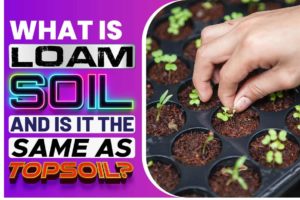
Many growers of all experience levels, often despite growing plants for years, still struggle to understand well known terminology and the difference between loam soil and topsoil.
Topsoil
In simple terms topsoil, (as you would expect from the name), comprises the uppermost layer of soil (usually the top 12 inches or so), and contains a very high concentration of organic matter.
As vegetation and microorganisms decompose on the surface soil, this filters down through the top soil and makes it high in levels of organic matter and nutrient rich.
Topsoil also often contains mineral particles, water and air and comes in two distinct varieties; screened topsoil and unscreened topsoil.
Unscreened topsoil is normally excavated but not sifted or “screened” and as such often contains large, unbroken particles and may additionally have stones, sticks, wood fragments, weeds and roots in it.
This thick, coarse and uneven topsoil is most often used when reshaping a garden, i.e. building slopes or ramps or as a base for raised flower beds.
Screened topsoil conversely has been sifted, (sometimes numerous times) to remove the big particles and detritus that would otherwise be part of its make up.
Free of the excess weeds, wood chips, stones and sticks, screened topsoil is made up of smaller, finer, less coarse particles that provide perfect drainage, allow better nutrient consumption and provide a better growing environment for optimal plant growth.
Screened topsoil is commonly used as a media for growing plants and flowers and even lawn laying and such versatility shows just how much more of a stable, efficient and clean growing environment it provides.
Loam Soil
The difference between loam soil and topsoil is similar to the difference between fingers and thumbs.
In the same way all thumbs are fingers but not all fingers are thumbs, then you can understand how all loam soils are topsoils but not all topsoil is loam soil.
Loam soil describes the specific texture of areas of topsoil that are most characterised by their propensity to contain large particles that make aeration possible and increase capacity of moisture movement.
Loam soil itself is made up of 40% sand, 40% silt and 40% clay and it is the clay part of the mixture that is most absorbent and is therefore ideal for water retention.
Water retention is of course vital for all growing plants but too much water will drown the plant and undo all your efforts.
This is where the silt comes into play. Whilst silt does hold some water, in comparison to clay it is very minor and more importantly silt actually allows for proper air circulation, something that is vital for plant growth.
Loam soil of course contains many more nutrients on average than standard sandy soils, and as such are key in the delivery of much needed nutrients for growing or undernourished plants.
Another advantage of loam soil is of course is that it is far easier to work with compared to heavier more compact growing media such as clay based soils.
No gardener wants to overexert themselves and by working with a lighter, more versatile less compact growing media like loam soil, they are better able to work longer at creating a more aerated, more optimal growing environment.
One of the main benefits of working with loam soil specifically is its versatility.
You are able to practically grow virtually anything in loam soil and some notable plants that do very well in it are; annual bedding plants, perennial flowering plants, fruit trees, soft fruits including blackcurrants, strawberries and raspberries and even a multitude of vegetables.
Loam is also the go to choice when building raised beds and adding even can help when laying a lawn as adding just a 15cm layer of loam soil can vastly improve long term sustainability of a lawn.
It is possible to make loam soil even better of course by increasing the amount of organic matter into the mixture or even doing something as simple as aerating the soil to prevent compaction and improve airflow.
Loam soil is readily available from most garden and growing retailers but you should remember that with the additional versatility, efficiency and all round efficacy of loam soil when compared to other varieties of topsoil there will be a price difference.
Whilst other topsoils are considered a satisfactory, if not, a fine medium for certain types of plants, most growers agree that to achieve best results you should use loam soil specifically, even if it comes at an additional cost.
In reality growing with other varieties of topsoil may cost you less in the short term but long term it may stop you achieving your growing goals as there is no guarantee that it will be able to provide the aeration, water retention or nutritional value that loam soil inevitably will.




















